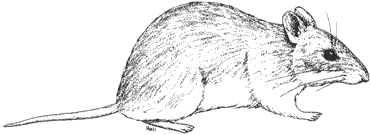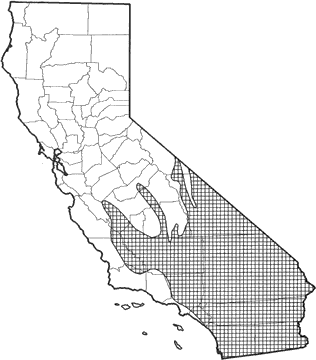
Southern Grasshopper Mouse
Distribution, Abundance, and Seasonality
Common in arid desert habitats of the Mojave Desert and southern Central Valley of California. Alkali desert scrub and desert scrub habitats are preferred, with somewhat lower densities expected in other desert habitats, including succulent shrub, wash, and riparian areas. Also occurs in coastal scrub, mixed chaparral, sagebrush, low sage, and bitterbrush habitats. Uncommon in valley foothill and montane riparian, and in a variety of other habitats.

Range Map
Specific Habitat Requirements
Feeding: Feeds almost exclusively on arthropods, especially scorpions and orthopteran insects (Horner et al. 1964). Sperry (1929) found the diet composed of 56% grasshoppers, crickets, caterpillars, and moths, and 21% ground and darkling beetles. Less than 5% was seeds. Vertebrate prey include salamanders, lizards, frogs, and small mammals (McCarty 1975). Both vertebrates and seeds are minor components of the diet (Bailey and Sperry 1929, Horner et al. 1964).
Cover: Low to moderate shrub cover is preferred.
Reproduction: Nests are constructed in burrows abandoned by other rodents (Bailey and Sperry 1929), or may be excavated.
Water: Drinks water in captivity, but probably obtains moisture from food under natural conditions. No specialized physiological adaptations to arid conditions
Pattern: Frequents desert areas, especially scrub habitats with friable soils for digging.
Species Life History
Activity Patterns: Active year-round. Nocturnal.
Seasonal Movements / Migration: None.
Home Range: Occurs in low density. Home ranges of grasshopper mice in New Mexico were 3.2 ha (7.8 ac) for males, and 2.4 ha (5.9 ac) for females (Blair 1943). In southeast Arizona, the average home range of adult mice was 11.45 ha (28 acres) (Chew and Chew 1970). In Nevada desert scrub, density averaged 1.83 mice/ha (0.74 mice/ac).
Territory: Territory size may equal home range (McCarty 1975). May occur in male-female pairs, widely separated from neighbors, and is highly territorial (Horner and Taylor 1968). High-pitched call may serve as territorial advertisement.
Reproduction: Peak breeding is from May to July, but may start in January under ideal conditions (Pinter 1970), and may continue year-round. Gestation is 27-30 days. Litter size averages 4 young (range 2-6). As many as 6 litters per yr in wild. Both males and females care for the young (Horner 1961). Weaning in the laboratory may occur in 20 days (Horner and Taylor 1968). Young females apparently have significantly greater reproductive potential than old females (McCarty 1975). Males store sperm at 40 days of age. Females can become receptive at 6 wk of age.
Niche: The southern grasshopper mouse overlaps greatly in niche characteristics with the northern grasshopper mouse, though it seems to prey more heavily on arthropods. In potential areas of overlap with O. Ieucogaster (in southern Mono Co.), O. torridus may occupy areas of lower elevation (McCarty 1975). No other likely competitors. Predators include raptors, snakes, and predatory mammals. Considered beneficial by farmers and others because eats potentially harmful insects.
Sources & References
California Department of Fish and Game, 1999.
California's Wildlife, Sacramento, CA.
Written by: P. Brylski, reviewed by: H. Shellhammer, edited by: R. Duke
Bailey, V., and C. C. Sperry. 1929. Life history and habits of the grasshopper mice, genus Onychomys. U.S. Dep. Agric. Tech. Bull. No. 145. 19pp. Blair, W. F. 1943. Populations of the deer mouse and associated small mammals in the mesquite associations of southern New Mexico. Contrib. Lab. Vertebr. Biol. Univ. Mich. No. 21. 40pp. Chew, R. M., and A. E. Chew. 1970. Energy relationships of the mammals of a desert shrub (Larrea tridentata) community. Ecol. Mongr. 40:1-21. Horner, B. E. 1961. Paternal care of the young and convulsive seizures in the grasshopper mouse. Amer. Zool. 1:360. Horner, B. E., and J. M. Taylor. 1968. Growth and reproductive behavior in the southern grasshopper mouse. J. Mammal. 49:644-660. Horner, B. E., J. M. Taylor, and H. A. Padykula. 1964. Food habits and gastric morphology of the grasshopper mouse. J. Mammal. 45:513-535. McCarty, R. 1975. Onychomys torridus. Mammal. Species No. 59. 5pp. Pinter, A. J. 1970. Reproduction and growth of two species of grasshopper mice (Onychomys) in the laboratory. J. Mammal. 51:236-243. Sperry, C. C. 1929. Laboratory studies of the food of Onychomys. U.S. Dep. Agric. Tech. Bull. 145:15-19.
California Animal Facts | California's Wildlife